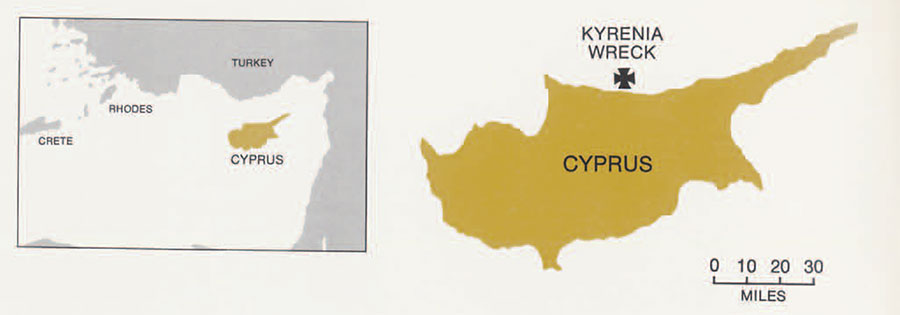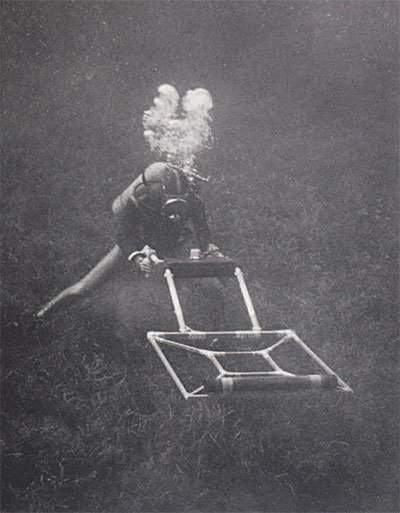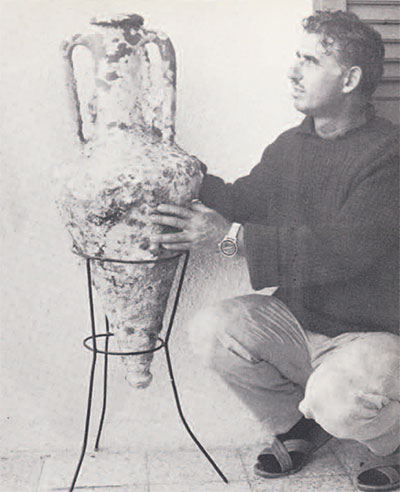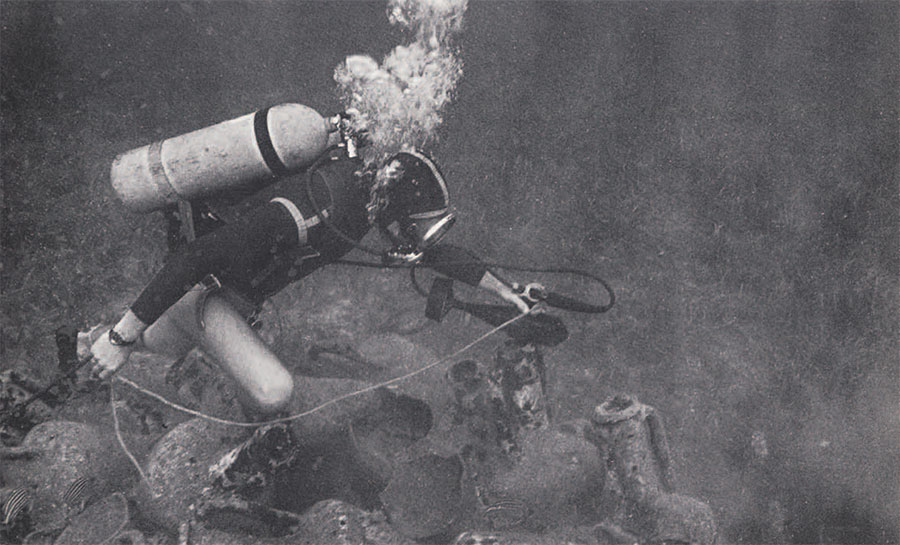 The 1967 survey expedition was made possible through the generous sponsorship of the University Museum; the Cyprus Mines Corporation of Los Angeles, whose offices on Cyprus also provided us with assistance in technical, mechanical, and medical problems; the National Geographic Society; the Dietrich Foundation, Inc. of Philadelphia; and the Houghton-Carpenter Foundation, also of Philadelphia. We wish to express thanks for their special assistance to Archbishop Makarios, President of the Republic of Cyprus; Dr. Vassos Karageorghis, Director of the Department of Antiquities; Ambassador Taylor Belcher and his staff of the American Embassy, Nicosia; and Mr. John D. Burgess, General Manager of the Cyprus Division of Cyprus Mines Corporation.
The 1967 survey expedition was made possible through the generous sponsorship of the University Museum; the Cyprus Mines Corporation of Los Angeles, whose offices on Cyprus also provided us with assistance in technical, mechanical, and medical problems; the National Geographic Society; the Dietrich Foundation, Inc. of Philadelphia; and the Houghton-Carpenter Foundation, also of Philadelphia. We wish to express thanks for their special assistance to Archbishop Makarios, President of the Republic of Cyprus; Dr. Vassos Karageorghis, Director of the Department of Antiquities; Ambassador Taylor Belcher and his staff of the American Embassy, Nicosia; and Mr. John D. Burgess, General Manager of the Cyprus Division of Cyprus Mines Corporation.
Over twenty-two centuries ago a merchant ship sailing the waters off the northern coast of Cyprus somehow came to grief and sank. The reason for her destruction remains buried with her some ninety feet below the surface. Her existence would be still unknown to us had it now been for a most extraordinary day some three years ago. Andreas Cariolou, a diver from the town of Kyrenia, had anchored his boat that day to gather sponges from a deep reef which he had visited many times before. He noticed nothing out of the ordinary as he assembled his diving gear and jumped over the side. In the silence of the sea he descended to the sponge bed and set about prying loose the sponges best in quality and stowing them in his bag. It was some time before he became aware that his anchor was beginning to drag away from the reef, heading toward the flat sea bed below. He knew that he dare not lose sight of it, for that would likely mean coming to the surface far from his boat. The anchor was moving fast into deep water. The sponger swam after it, just able to keep in sight the wisps of mud it was turning up as it bumped away. As he was straining to match the anchor’s pace he caught sight of a mound of shapes unfamiliar to him on the sea bed. Forgetting the anchor, Andreas swam towards the curiosity. He lived then a moment few men will ever know in a diving lifetime. In the sand before him lay a pile of ancient wine jars stacked in neat rows, as on the deck of some ancient merchantman. The diver hovered over the mound to the last minutes of his limited air supply. He broke surface to find himself in the midst of the sudden storm which had just dragged his boat almost half a mile towards shore. He swam for the boat, his diving equipment now a burden in a near gale sea, and in so doing he did not think to take bearings on the spot where the ancient cargo lay. Indeed, he was to spend the next three years searching before he rediscovered the wreck and was able to chart its location.
The story is dramatic, and it would be doing it an injustice to tell it in anything less than these terms. Every discovery of a new segment from antiquity is, of course, momentous. But for a diver the sensation must be multiplied, for he moves in an environment to which he is ill-suited. He is not free to stay there long or survey great distances or move at all quickly through the water. It is simply an incredible bit of fortune that brings him upon a deep shipwreck. Three years ago Mr. Cariolou lived an extraordinary day, and it is to the good fortune of the University Museum that he did.
 When our search team arrived on Cyprus to begin a survey for ancient shipwrecks we heard it rumored that the diver at Kyrenia knew of “some sunken pottery.” We had located four shallow wrecks in depths of ten to seventy feet, ranging in date from the Hellenistic to Early Byzantine periods, before the time when we were able to meet with Mr. Cariolou. He aggreed to show us something he had just recently refound. With directions as precise as “move the boat twenty feet back and ten feet left,” he put our first team of divers directly on the wreck.
When our search team arrived on Cyprus to begin a survey for ancient shipwrecks we heard it rumored that the diver at Kyrenia knew of “some sunken pottery.” We had located four shallow wrecks in depths of ten to seventy feet, ranging in date from the Hellenistic to Early Byzantine periods, before the time when we were able to meet with Mr. Cariolou. He aggreed to show us something he had just recently refound. With directions as precise as “move the boat twenty feet back and ten feet left,” he put our first team of divers directly on the wreck.

Mr. Cariolou is an unusual man. He has not only an interest in the antiquity of Cyprus but also an intense concern for the future of his community. He told us much later that few people knew of the wreck’s presence, that he had been guarding it against intruders for the time when archaeologists capable of dealing with the find should come to Kyrenia. It had been his fear that weekend divers from the numerous foreign missions on the island might rob the site systematically and disperse the cargo to their own countries. Our director assured him that the Museum team would excavate the ship with care and would preserve its artifacts and the story of its excavation for the town of Kyrenia, hoping to establish there a museum to display the results.
We then set ourselves to learn as much as possible from the amphora mound before returning to the Museum to plan its excavation. A curious feature of the site is that the amount of cargo visible is exceedingly small, measuring only ten by sixteen feet. Were we dealing with an ancient “miniature”—perhaps a dingy? We wished to know whether the cargo extended further beneath the sand and, if so, what would be the nature of some of the objects lying in the wreckage. We had for this purpose two metal detecting instruments: the proton magnetometer designed by Dr. E. T. Hall, Oxford, for underwater survey; and a newly developed metal detector devised by Mr. Jeremy Green, also from Oxford.

Our first task was to lay over the wreck site some means of orientation. We fashioned a simple cord grid 10 x 28 meters and divided it into two-meter squares. Being non-metallic, this would not interfere with the metal sensing instruments. Moving across this grid with the proton magnetometer, we located two fairly large concentrations of iron very close to the visible amphora mass. They lie about three feet under the sand. With the metal detector we again located these iron deposits but also charted seven additional concentrations of metallic substance. Having plotted these, we realized that the wreck was indeed larger than the small mound would suggest.
Using then a thin metal rod, we systematically probed the surrounding sand to determine the extent of the amphora cargo. It proved to measure approximately 33 x 63 feet, suggesting the size of the vessel below. The distribution of the submerged cargo furthermore showed that the true axis of the wreckage is at some angle to that suggested by the visible mound. Knowing this true axis, we will be able to position a more permanent reference grid with some accuracy once excavation begins.
Three different types of amphoras make up the cargo we can see, and these form the basis for our fourth century dating. The predominant type has been dated by Miss Virginia Grace of the American School of Classical Studies at Athens to the last third of the fourth century before Christ. She believes that they were manufactured on Rhodes and indeed stand as the earliest known style of wine jars produced on that island. The origins of the other two types are as yet unknown.

The excavation of this wreck beginning in 1968 will add yet another ship to our growing catalogue of merchant vessels. It is, to date, the finest preserved Classical Greek shipwreck yet reported. The fact that it lies on a muddy sand bottom suggests that the wood from the hull remains sufficiently intact to provide us with the material to reconstruct the vessel’s hull design. Standing as it does in the 1,700 year span between the Museum’s Late Bronze Age shipwreck at Cape Gelidonya and current excavation of a Roman ship at Yassi Ada, it promises to fill an important chapter in our log of seafaring within the ancient Mediterranean world.
